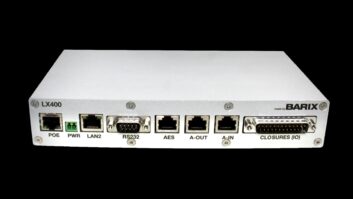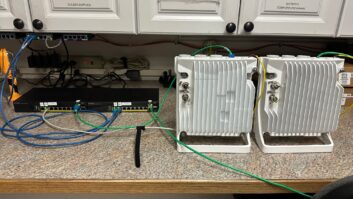The use of audio-over-internet protocol codecs for STL applications is becoming more and more commonplace. This is especially important now because the large telcos are much more interested in providing high-speed IP connectivity than they are in providing (what we could now consider) old-fashioned wirelines.
This month we�re going to look at the players you know and some you may not in this space. In addition, we�ll cover the companies that have methods in place to share multiple, different network connections to pass audio from point A to B.
COMREX
CrossLock is the name given by Comrex to the technology, employed in BRIC-Link II, enabling the simultaneous use of two networks and the transmission of two identical streams over them.

For nailed-up STL connections, consider the Comrex BRIC-Link II. It�s a full-duplex stereo encoder and decoder in a small form-factor package, and it offers a stereo or mono linear mode that does not compress audio, in addition to FLAC lossless compression, AAC/HE-AAC modes, Opus, and VoIP standards G.722 and G.711. Its built-in jitter buffer manager automatically balances delay and stability, dynamically increasing and decreasing delay based on network performance. End-to-end coding delay in linear modes is less than 25 mS and FLAC modes are less than 30 mS.
CrossLock is the name given by Comrex to their technology employed in BRIC-Link II, enabling the simultaneous use of two networks and the transmission of two identical streams over them. In the event of network issues, CrossLock provides a seamless transition between the two audio paths.
BRIC-Link II has an embedded web interface, allowing the user to access all controls remotely. The page displays connection status, network diagnostics and audio level meters for remote monitoring. Users are also able to configure profiles for various connections with point-and-click connection commands.
TIELINE
In addition to two IP network connections, the end-user can configure the Tieline Genie STL to make use of ISDN or POTS for end-to-end connectivity.

Tieline�s Genie STL is also a single RU, full-duplex audio codec capable of sending 24 bit 96 kHz SR linear PCM audio or by way of the following audio codec algorithms: Enhanced aptX, LC-AAC, HE-AAC v1 and v2, AAC-LD, AAC-ELDv1 and v2, Opus, MPEG II, MPEG Layer-3, Tieline Music and MusicPLUS, G.722 and G.711 algorithms. The unit features auto-switching, dual redundant AC power supplies, dual 1 Gigabit (10/100/1000) Ethernet ports, a low-latency in-band RS-232 aux data channel, and codec �wizards� and GUI for configuration and control.
Genie STL can also fail over to backup ISDN or POTS connections using optional ISDN or POTS modules.

The Genie features automated jitter buffer management, FEC and error concealment techniques. These features dynamically respond to variable conditions over unmanaged IP networks such as the public internet. Tieline also offers a feature known as SmartStream Plus which operates as such:
1. The codec can stream simultaneous redundant data streams from both Ethernet ports, allowing it to deliver redundancy by switching back and forth, without loss of audio, from the nominated primary data link to the backup link if one fails and then subsequently recovers. (Using IP links from two different IP network providers is recommended.)
2 .When multiple redundant audio streams are sent, the decoding codec automatically reconstructs audio into a perfect single stream on a first-packet-arrived basis to ensure audio integrity.
TELOS
Telos Z/IP One features dual Ethernet ports for separate streaming and control: LAN for local control with Livewire audio and GPIO, a separate port for connections to wide-area networks.

The Telos Z/IP One is a 1 RU rack-mount IP codec that users typically associate with remote broadcasting, but it can be used for nailed-up STL connections as well. Z/IP One includes the codec algorithms for AAC-ELD, AAC-HE, AAC-LD, MPEG 4 AAC, MPEG 2 AAC, MPEG Layer 2, G.711, G.722 codecs, plus linear audio and (optionally) aptX Enhanced coding. It includes dual Ethernet ports for separate streaming and control: LAN for local control with Livewire audio and GPIO, and a separate WAN port for connections to wide area networks.
Z/IP has both analog and AES inputs/outputs.
The user configures it via its built-in Web server. �Push Mode� is used for one-way network transmission to a single location, and �Multiple Push Mode� is used for audio distribution to multiple destinations. A time-aligned RS-232 channel is available for remote control or metadata, e.g., RDS. A time-aligned 8-bit parallel GPIO port is available for signaling and control.
WORLDCAST
Worldcast�s Surestreamer is unique in that it can sit in front of any existing single-port IP audio codec from any manufacturer. It�s agnostic to the codec device (as long as they use UDP or RTP).

Worldcast has an extensive line of AoIP codecs � including the APT IP Codec and the IP Silver � but the device that I want to make sure you know about is the Surestreamer.
Like some of the other codec devices manufacturers mentioned in this article, APT�s Surestream is a means by which more than one network is used to move IP packets from one end to the other, but the Surestreamer is unique in that it�s an outboard unit, and it can sit in front of any existing single-port IP audio codec from any manufacturer. It�s agnostic to the codec device (as long as they use UDP or RTP). Like the other redundancy schemes we�ve talked about, Surestreamer continues to provide a continuous audio stream, even when one of the contributory links suffers a total Loss of Connection. Surestreamer�s dual IP ports can be connected to two wired networks or via a wired and a wireless network.
Surestreamer can also be deployed as a multicast or multiple unicast node to reduce connectivity costs by migrating the stream replication function away from the source encoder and closer to the decoding devices.
Configuration of the Surestreamer is done by way of its embedded webserver. It functions both as an SNMP manager and agent. Performance monitoring and system event logging is provided. Data throughput for LAN connections is 10 Mb/s; for the LAN, 20 Mb/s (and varies with packet size).
DEVA
When powered up, the DEVA DB910 device will announce its IP address through the headphones. It can use DHCP to derive an IP address, and UPnP is included for local discovery.

DEVA has an extensive line of broadcast products, including the DB910, a small form-factor, full-duplex audio codec. The DB910 has analog inputs/outputs as well as AES ins/outs, all accessible via 1/4-inch TRS connectors. (32, 44.1 and 48 kHz SR supported.) Codec algorithms include linear PCM, HE- AAC (versions 1 and 2), as well as MPEG-1 and MPEG-3 (decoding).
Configuration of standard bitrates, and variable bitrate, are supported on the encode side. It will stream as a Shoutcast/Icecast compatible TCP server, or Icecast Source Client using RTP. By way of its built-in MP3 player (SD-card based), it can provide backup audio for the decode side in the event the stream is lost. The unit includes six general purpose inputs/outputs for signaling end-to-end or remote control. The user configures the DB910 via its embedded web server, using a standard browser.
When powered up, the device will announce its IP address through the headphones. It can use DHCP to derive an IP address, and UPnP is included for discovery of local networks.
GATESAIR
IP Link MPX was designed specifically for MPX over AES transport via IP.

The GatesAir Intraplex IP Link family of IP audio codecs includes the IP link 100 (Single set of bidirectional stereo audio channels), the IP link 200 (two sets of bidirectional stereo audio channels) and the IP Link MPX.
Each of these devices needs 1 rack unit of vertical space. Standard codec algorithms include linear, AAC-LC, Opus and G.722; optional codecs available are AAC-HE, AAC-HEv2, AAC-ELD, MPEG2, MPEG3 and Enhanced aptX. Transparent AES (at 192 KHz SR) also supports MPX over AES (also optional). Protocol encapsulation includes MPEG-TS, RTP and Shoutcast/icecast. Configuration and control of IP Link is done via its embedded web server (using any of the IP interfaces).
Optionally, the IP link includes �stream splicing,� which allows the device to switch from one IP stream to another (provided over separate networks) for the sake of redundancy.

The IP link codec includes three separate Ethernet ports and thus supports redundant network connections. Optionally, the IP link includes a feature known as �stream splicing,� which enables the device to switch from one IP stream to another (provided over separate networks) for the sake of redundancy. Silence sensing can be used to activate the switching process � and the IP Link can also switch to a USB drive or another audio source should the need arise. IP Link can also encode the same audio source in different formats for primary and secondary STL connections or those to a streaming service.
The IP Link MPX is, as its name suggests, designed specifically for MPX over AES transport via IP. Flexible sampling rates and sample size options allow the user to optimize the needed bandwidth. The unit features a single bidirectional FM MPX composite signal, redundant input MPX signal ports with automatic failover based on signal activity and redundant output MPX signal ports. Two channels of SCA mixing are available. GPS support for precision digital timing reference and the SynchroCast option provide dynamically managed precision delay for single-requency network broadcasting and simulcasting.
DIGIGRAM
Digigram Iqoya supports VLAN tagging (802.1q and 802.1p), DSCP (otherwise known as DiffServ) and can stream in unicast, multi-unicast, multicast and multi-multicast formats.

Digigram is probably not a company you associate with AoIP codecs, but they have an extensive line. The Iqoya is a single RU, full-duplex codec with two RJ45 ports that can be used for separating management traffic from streaming traffic or for the generation of redundant streams (with up to 2 seconds of delay in the redundant stream).
Iqoya supports VLAN tagging (802.1q and 802.1p), DSCP (otherwise known as DiffServ) and can stream in unicast, multi-unicast, multicast and multi-multicast formats. Like many of the other codecs in this article, it also manages network conditions often seen on the public internet � excessive jitter, lost packets, duplicated packets, and disordered packets; it also features selectable FEC (+10 percent, +20 percent, +33� percent, +50 percent, +100 percent).
Iqoya is FNS/ACIP compliant (EBU Tech 3326) and will stream in RTP or UDP modes, in addition to HTTP streaming (Icecast/Shoutcast). Auxiliary data transport is done in-band via data tunneling, supporting RS-232 (RDS UECP) and eight GPIOs. Control, monitoring, alarming can be done through SNMP (SET, GET, Traps) and configuration is done via a secure web connection (https) and FTP connections.
BARIX
The Barix exstreamer 500 is a full-duplex codec with balanced audio inputs and outputs, by way of phoenix connectors.

Barix is among the most well-known AoIP codec manufacturers and has an extensive product line. The exstreamer 500 is a full-duplex codec with balanced audio inputs and outputs (using phoenix connectors). The encoding side can make use of MP3, G.711 or PCM; the decoder can make use of those in addition to AACPlus and Ogg Vorbis. Streaming protocols include TCP, UDP, RTP and multicast. The exstreamer 500 also supports four relay inputs, four relay outputs, and serial in/out (RS-232 or 485). Configuration is done via its embedded web server.
STL applications don�t require full-duplex codecs and for this reason you could always consider the well-known instreamer (encoders) and exstreamers (decoders) from Barix to send audio in one direction only. Common features between instreamer and exstreamer include the AACplus, MP3, Ogg Vorbis and G.711 algorithms (in addition to PCM); inputs/outputs via RCA connectors, RS-232 support, and the need for an external power supply (9-30 VDC, 12-24 VAC), which comes supplied. Configuration is done via the embedded web servers.
2WCOM
By way of an optional GPS interface, and using PTP, the 2wcom MM01 can be used for microsecond accurate latency control in single frequency network applications.

2wcom is a manufacturer with which you may not be familiar. Their MM01 is single rack unit, full-duplex codec suited for STL purposes. Codec algorithms included are MPEG layers 1, 2 and 3 and PCM. Optionally the MM01 can use MPEG 2/4 AAC LC, HEv1 and v2, AAC-LD, Enhanced-aptX, or MPX over AES (192 kHz SR). In addition, the MM01 supports EBU Tech 3326, Ravenna, Livewire, precision time protocol, session announcement protocol, session initiation protocol and session description protocol. Configuration of the MM01 is done via an embedded web server, and the unit supports SNMP control.
The MM01 includes two Ethernet WAN ports and can make use of what 2wcom calls Stream4Sure seamless switching, using their dual streaming mechanism: redundant contribution of IP packets to different transmission paths. (Another Ethernet port is included for management purposes.)
Optionally, the MM01 can use GPS and, by way of PTP, can be used for microsecond accurate latency control in single-frequency network applications.
MAYAH
Mayah GeMINI Studio supports eight channels in and out simultaneously, in analog and AES formats.

Another long time manufacturer of IP codecs is Mayah. Their GeMINI Studio is a small codec, offered in two variations: 1 RU, half-rack width, with an external power supply, and 1 RU, full-rack width, with redundant power supplies.
GeMINI Studio supports eight channels in and out simultaneously, in both analog and AES formats (using dB type connectors). Codecs supported include OPUS, FLAC and AAC HE. The unit also supports AES67, RTP, RTSP and SIP.
AEQ
AEQ has been in the audio codec field for many years and offers (among others) the Phoenix Venus 3, a single RU full-duplex codec with both analog and AES inputs/outputs.
It supports SIP and is 100 percent compatible with N/ACIP EBU Tech-3326 technical recommendations; codec algorithms included are G.711, G.722, MPEG-2, OPUS, and AEQ�s LD low delay algorithms. AAC algorithms are provided as options.
The Venus 3 supports SNMP, providing one means by which the user can monitor its status, and alarms. It also includes four sets of GPIOs. Via its Ethernet interface it can be controlled remotely by way of a PC; included in the control software are real-time VU meters, contact list management, event logs and alarm logs.
When studying any device type, whether it�s consoles or transmitters or audio codecs, make sure you include the usual suspects as well as manufacturers you don�t know as well. Sometimes it seems a bit risky to go with an unfamiliar manufacturer, but keep in mind that none of them has a monopoly on good ideas or methodology.
The underlying technology is the same (i.e., sending IP packets from one location to another), and each is dealing with the same network issues (packet loss, out-of-order packets, delayed packets, etc.) so most of these designs are going to have more similarities than differences. Comparing features can provide a useful learning experience.







